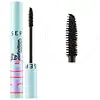Maybelline Snapscara Versus Sephora Collection Big By Definition Defining & Volumizing Waterproof Mascara
What's inside
What's inside
 Key Ingredients
Key Ingredients

 Benefits
Benefits

 Concerns
Concerns

No concerns
 Ingredients Side-by-side
Ingredients Side-by-side

Water
Skin ConditioningStyrene/Acrylates/Ammonium Methacrylate Copolymer
Butyrospermum Parkii Butter
Skin ConditioningPropylene Glycol
HumectantGlyceryl Stearate
EmollientDimethicone
EmollientPolybutene
PEG-100 Stearate
Behenyl Alcohol
EmollientSorbitol/Sebacic Acid Copolymer Behenate
Skin ConditioningDivinyldimethicone/Dimethicone Copolymer
Glyceryl Stearate Citrate
EmollientDisodium Ethylene Dicocamide PEG-15 Disulfate
CleansingPhenoxyethanol
PreservativeCaprylyl Glycol
EmollientGlyceryl Dibehenate
EmollientGlycerin
HumectantAmmonium Polyacryloyldimethyl Taurate
Emulsion StabilisingDimethicone/Vinyl Dimethicone Crosspolymer
Skin ConditioningSilica
AbrasiveButylene Glycol
HumectantPotassium Sorbate
PreservativeTribehenin
EmollientXanthan Gum
EmulsifyingDimethiconol
EmollientTocopheryl Acetate
AntioxidantSodium Laureth Sulfate
CleansingGlyceryl Behenate
EmollientBHT
AntioxidantEthylhexylglycerin
Skin ConditioningDisodium EDTA
C12-13 Pareth-23
CleansingC12-13 Pareth-3
EmulsifyingTetrasodium EDTA
Methicone
EmollientTocopherol
AntioxidantCitric Acid
BufferingCI 77491
Cosmetic ColorantCI 77492
Cosmetic ColorantCI 77499
Cosmetic ColorantCI 77007
Cosmetic ColorantCI 75470
Cosmetic ColorantCI 77891
Cosmetic ColorantCI 77288
Cosmetic ColorantCI 42090
Cosmetic ColorantCI 19140
Cosmetic ColorantCI 16035
Cosmetic ColorantMica
Cosmetic ColorantCI 77742
Cosmetic ColorantCI 77510
Cosmetic ColorantFish Oil
Skin ConditioningCeramide AP
Skin ConditioningWater, Styrene/Acrylates/Ammonium Methacrylate Copolymer, Butyrospermum Parkii Butter, Propylene Glycol, Glyceryl Stearate, Dimethicone, Polybutene, PEG-100 Stearate, Behenyl Alcohol, Sorbitol/Sebacic Acid Copolymer Behenate, Divinyldimethicone/Dimethicone Copolymer, Glyceryl Stearate Citrate, Disodium Ethylene Dicocamide PEG-15 Disulfate, Phenoxyethanol, Caprylyl Glycol, Glyceryl Dibehenate, Glycerin, Ammonium Polyacryloyldimethyl Taurate, Dimethicone/Vinyl Dimethicone Crosspolymer, Silica, Butylene Glycol, Potassium Sorbate, Tribehenin, Xanthan Gum, Dimethiconol, Tocopheryl Acetate, Sodium Laureth Sulfate, Glyceryl Behenate, BHT, Ethylhexylglycerin, Disodium EDTA, C12-13 Pareth-23, C12-13 Pareth-3, Tetrasodium EDTA, Methicone, Tocopherol, Citric Acid, CI 77491, CI 77492, CI 77499, CI 77007, CI 75470, CI 77891, CI 77288, CI 42090, CI 19140, CI 16035, Mica, CI 77742, CI 77510, Fish Oil, Ceramide AP
Isododecane
EmollientCera Microcristallina
Emulsion StabilisingWater
Skin ConditioningCI 77499
Cosmetic ColorantKaolin
AbrasiveEuphorbia Cerifera Wax
Trimethylsiloxysilicate
EmollientVp/Eicosene Copolymer
Hydrogenated Polycyclopentadiene
Copernicia Cerifera Wax
Disteardimonium Hectorite
StabilisingButylene Glycol
HumectantRicinus Communis Seed Oil
MaskingSorbitan Isostearate
EmulsifyingPropylene Carbonate
SolventEthylhexylglycerin
Skin ConditioningPotassium Sorbate
PreservativeSodium Dehydroacetate
PreservativeHydrolyzed Vegetable Protein
Skin ConditioningCaprylyl Glycol
EmollientPolyester-4
Skin ConditioningSimmondsia Chinensis Seed Oil
EmollientYeast Extract
Skin ConditioningLeuconostoc/Radish Root Ferment Filtrate
AntimicrobialSodium Benzoate
MaskingTocopherol
AntioxidantIsododecane, Cera Microcristallina, Water, CI 77499, Kaolin, Euphorbia Cerifera Wax, Trimethylsiloxysilicate, Vp/Eicosene Copolymer, Hydrogenated Polycyclopentadiene, Copernicia Cerifera Wax, Disteardimonium Hectorite, Butylene Glycol, Ricinus Communis Seed Oil, Sorbitan Isostearate, Propylene Carbonate, Ethylhexylglycerin, Potassium Sorbate, Sodium Dehydroacetate, Hydrolyzed Vegetable Protein, Caprylyl Glycol, Polyester-4, Simmondsia Chinensis Seed Oil, Yeast Extract, Leuconostoc/Radish Root Ferment Filtrate, Sodium Benzoate, Tocopherol
Ingredients Explained
These ingredients are found in both products.
Ingredients higher up in an ingredient list are typically present in a larger amount.
Butylene Glycol (or BG) is used within cosmetic products for a few different reasons:
Overall, Butylene Glycol is a safe and well-rounded ingredient that works well with other ingredients.
Though this ingredient works well with most skin types, some people with sensitive skin may experience a reaction such as allergic rashes, closed comedones, or itchiness.
Learn more about Butylene GlycolCaprylyl Glycol is a humectant and emollient, meaning it attracts and preserves moisture.
It is a common ingredient in many products, especially those designed to hydrate skin. The primary benefits are retaining moisture, skin softening, and promoting a healthy skin barrier.
Though Caprylyl Glycol is an alcohol derived from fatty acids, it is not the kind that can dry out skin.
This ingredient is also used as a preservative to extend the life of products. It has slight antimicrobial properties.
Learn more about Caprylyl GlycolCi 77499 is also hydrated iron III oxide. It is created from mixing red and black iron oxides. This helps give shades of darkness to a product.
Iron III oxides are classified as inorganic chemicals for coloring.
Ethylhexylglycerin (we can't pronounce this either) is commonly used as a preservative and skin softener. It is derived from glyceryl.
You might see Ethylhexylglycerin often paired with other preservatives such as phenoxyethanol. Ethylhexylglycerin has been found to increase the effectiveness of these other preservatives.
Potassium Sorbate is a preservative used to prevent yeast and mold in products. It is commonly found in both cosmetic and food products.
This ingredient comes from potassium salt derived from sorbic acid. Sorbic acid is a natural antibiotic and effective against fungus.
Both potassium sorbate and sorbic acid can be found in baked goods, cheeses, dried meats, dried fruit, ice cream, pickles, wine, yogurt, and more.
You'll often find this ingredient used with other preservatives.
Learn more about Potassium SorbateTocopherol (also known as Vitamin E) is a common antioxidant used to help protect the skin from free-radicals and strengthen the skin barrier. It's also fat soluble - this means our skin is great at absorbing it.
Vitamin E also helps keep your natural skin lipids healthy. Your lipid skin barrier naturally consists of lipids, ceramides, and fatty acids. Vitamin E offers extra protection for your skin’s lipid barrier, keeping your skin healthy and nourished.
Another benefit is a bit of UV protection. Vitamin E helps reduce the damage caused by UVB rays. (It should not replace your sunscreen). Combining it with Vitamin C can decrease sunburned cells and hyperpigmentation after UV exposure.
You might have noticed Vitamin E + C often paired together. This is because it is great at stabilizing Vitamin C. Using the two together helps increase the effectiveness of both ingredients.
There are often claims that Vitamin E can reduce/prevent scarring, but these claims haven't been confirmed by scientific research.
Learn more about TocopherolWater. It's the most common cosmetic ingredient of all. You'll usually see it at the top of ingredient lists, meaning that it makes up the largest part of the product.
So why is it so popular? Water most often acts as a solvent - this means that it helps dissolve other ingredients into the formulation.
You'll also recognize water as that liquid we all need to stay alive. If you see this, drink a glass of water. Stay hydrated!
Learn more about Water